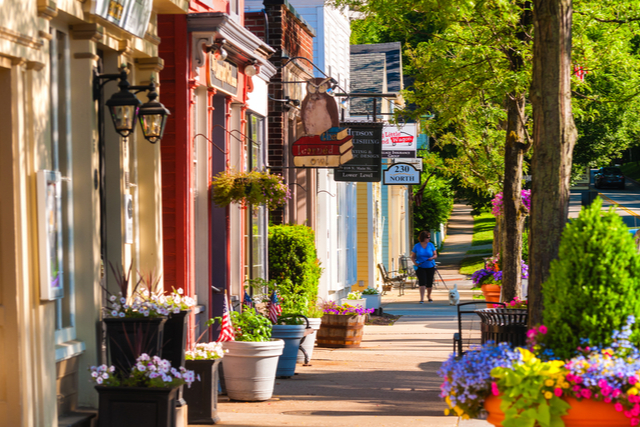
Is Your Town the Perfect Setting?
You’ve always thought that bar on Main Street where the old-timers and the lowlifes hang out together because there’s a pool room in the back would make the perfect setting for your neo-noir novel. Or maybe the feud between the Townies and the Farmers at the high school is the perfect backdrop for your teen romance.
Wherever inspiration is calling from, you’ve decided you want to use your town in your novel. The thing is, people know you, and if you’re writing a neo-noir with local color, your neighbors might be offended.
So, how do you go about using what you know about your town to make your setting believable while adding enough fictional flair that an angry mob doesn’t come knocking down your door?
Things to Consider When Fictionalizing Your Hometown
It’s easy to use your real town because you know all the setting details—weather, culture, town history, local politics.
But even if you set your novel in a real place, you’ll be surprised at how much you don’t know and the research you still have to do to write a convincing novel.
You may have a general idea, but probably couldn’t draw a map and locate buildings without online help. Your characters will move from one place to another. You’ll need to know.
Your main concern is other people, real people, who live there. Even if you portray them in a positive role, they may still be unhappy appearing in your novel. They may hate your genre and feel demeaned. Or misinterpret what you say. You can’t make everyone happy. It’s best to fictionalize your town characters.
Consider adding fictional elements in your town, like an imaginary street, or an imaginary hotel on a real street. You’ll build your setting according to your story requirements rather than trying to twist your story to fit into real-world limitations.
Root the Fictional Town with Your Emotions
Your associations and memories of your locale will be the basis for your setting. You want to give your reader a sense of your town—of the reason you want to set your story there—and this comes from how it makes you feel more than where the grocers is.
Build your town around the way you want it to shape your characters, or the way it has shaped you.
How to Name Your Fictional Town
Your town is central to your story so you're looking for a name that resonates with its central themes or its wider setting. Depending on your genre, you may want a realistic name or a thematic name.
Creating a Realistic Fictional Name
Different areas tend to name towns in a regional manner. In the southwest, including southern California, many towns have Spanish names. In the Northeast, they may echo towns in England or have Dutch names.
In the Dordogne, in France, many towns end with -ac, for example, Bergerac. Naming your town with a regional name helps readers relate the town to the geographic area.
Wikipedia is your friend here. It lists all the towns in a county, so you’ll have plenty of prompts for naming your fictional town. You’ll see populations as well, and that will give you an idea of how different-sized municipalities are named. Small towns can give you ideas for picturesque and unique names.
Creating a Thematic Name
Thematic names work well in fantasy stories. And, they’re fun to create. Use your imagination to brainstorm theme-related names. Use dictionaries for words that have not been current for over a hundred years.
Be careful with thematic names, though. Don’t make them too obvious. Necromancia, Ohio, won’t work for your vampire story. Readers appreciate subtlety.

Town History and Lore
Every town has its history and lore. Even though you may not use much of this material in your story, you still want a sense of history, because one detail may be crucial to the plot. You won’t know that detail until you have a history.
Was it founded by Dutch settlers, Swedish immigrants, Spanish Californios? Who was the founder? What was their unique contribution? Did they pace out the town square using a compass?
Is it a college town? A mill town? Was it a former mill town and now a bedroom community?
Read local histories of other towns in the area to give you prompts.
Don’t forget to include local lore. The widow in the mansion who is the last descendent of the founding family. The college motto. The haunted park. Lore creates a personality for your town.
Town Details
Details bring verisimilitude to your fictional town. From street names to local architecture, your readers feel as though they know the town.
Readers empathize with your characters. They want to feel themselves moving about the town in the same way your protagonist goes from place to place.
Is the ground flat or hilly? Are homes two-story brick or sprawling Spanish-style bungalows? It doesn’t matter if your protagonist lives in the one apartment building in the center of your town, what is the rest of the town like? Is there a town center?
Or are you in a multi-mall bedroom community? Are there wall-to-wall townhouses or older homes with lawns and trees? What’s it like on “the other side of the tracks?”
Use real estate listing sites like Redfin or Zillow to find homes for your characters. These sites have photos of all the rooms and the exteriors.
Are the streets laid out in a grid? Or do they turn and ramble? Are there long country roads leading out of town?
What are the local hotspots? Where do the wealthy relax? Where do lonely teenagers hang out? Is your protagonist a cop that goes to the local cop bar? Does your antagonist spend time at the country club? Or the yacht harbor?
If you feel your real town lacks an element you want in your story, go ahead and add it to your fictional town. That’s one of the benefits of fictionalizing your town. You can give your fictional town whatever it needs to impact your story.
Whatever your drawing skills, draw a map. Locate major town buildings, your hero’s local hangouts, and the homes of the major characters. You may want floor plans for the homes of major characters or buildings where major scenes take place.
Root your fictional setting in the real world, especially if it is near a big city. Give your readers a sense of place by mentioning real towns, events, and headlines from the time of your story.
Readers have no preconceptions of your fictional town, so you create your understanding in your story.

Fuse Real Emotions with Your Fictional Town
You fictionalized your home town because you felt it was the perfect setting for your story. “Felt” is the operative word. For your story, you want to transfer all the emotional truth about the town that inspired you.
What is emotional truth? Award-winning journalist and YA novelist Robin Farmer describes it as follows:
Emotional truth allows readers to feel a certain way about the experiences of people who may lead different lives from them. It’s the lens that allows us to see ourselves in a story that results in a heartfelt connection to a fictional narrative. Emotional truth transcends facts.
You want to use the evocative details of your town to create an emotional connection with your story. Include:
- Weather. How do your characters respond to the weather? Do they love it? Hate it? Tap into your personal reactions.
- Geography. Does your character slip and slide on a treacherous muddy hillside? Do they wish they could see a tree, just one tree? Do the waves crash outside the windows when she wakes up? Does she love the sound?
- Challenges. How does your town challenge your characters? Do they feel trapped and going nowhere with nowhere to go in a small town? Do the myriad streets and towering buildings keep them from seeing that character they need to see right now?
- Lore. Does your character believe the town lore or think it’s poppycock? How does their belief get them into trouble? Has your heroine just debunked the stellar reputation of a town founder?
- Emotional sites. Transfer your feelings to your characters. You know your town. Where do you feel comfortable? Where do you use your street smarts? What neighborhoods do you avoid? Why? Transfer your personal responses to your characters.
Dig deep into your connection with your real town to bring out the impact of the fictionalized town on your characters.
Transforming the emotional resonance of your town into your fictionalized story universe helps you build empathy with your readers. Empathy makes readers care about your characters and keeps them turning pages.


